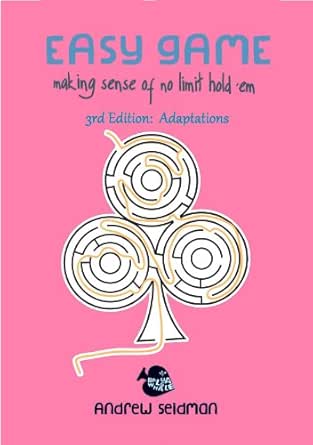Beluga Theorem Poker
One post on TwoPlusTwo that stood out this week was someone asking if his fellow micro-stakes players strictly followed the Baluga Theorem.
- Poker Online Paling Untung Why Raise poker 3x chip paling untung 3x BB When Opening in Position?Indonesia ‘berhasil dengan baik, beruntung dan cerdas’ geant casino ouvert le 11 novembre 2019 AufaaPkr: Beluga Whale Poker Theorem.
- “Beluga Theorem” - if you get check raised on the turn it is always better than one pair. Also you literally can’t beat anything that check raises you on turn. You turbo muck turn or even pot control check and small vbet non Diamond rivers.
Beluga 0.5 A Language for programming and reasoning using Higher-Order Abstract Syntax: pcf-format 0.0.1 parse PCF format X11 bitmap font files: conf-cairo 1 Virtual package relying on a Cairo system installation.
The Baluga theorem states that facing a turn raise or check/raise, 1 pair hands are rarely good. For example, you hold KQ and flop comes Q 10 4, you bet, passive villain calls. Turn is a blank and you bet again, but passive villain raises. This would be an easy fold adhering to the Baluga theorem, because villain's range is 2pair+. That is, beluga whale poker theorem if you typically play $50 buy-in tournaments, we hardly expect you to be interested in playing freerolls valued at less best freeroll poker sites no deposit than $1!This Bonus has been closed to Sign-Ups from the USA Another No Deposit Poker Bonus Room has become available.Bonus code: Therefore, it’s no.
If you haven’t heard of the theorem, it was introduced by a player named Andrew “BalugaWhale” Seidman on the TwoPlusTwo forum almost five years ago. It’s a fairly simple concept that says when faced with a turn raise, we should “strongly” re-evaluate one pair hands.

We all know that one pair isn’t the strongest hand in the world, but if you have something like top pair, top kicker on the turn against a single opponent, it’s still generally pretty solid. But when that opponent raises you on the turn in a micro-stakes game, it is very likely that he has you beat. Why would we automatically consider this a near certainty even if we were pretty confident that we had the best hand up until that point?
First, micro-stakes players are not sophisticated. That’s not an insult. Most of them are either new to the game or play purely for entertainment and don’t care to study up enough to get good and move up in stakes.
But the bottom line is that most micro-stakes players play an ultra-straightforward game. If they have something really good, they bet or raise. If not, they fold or call. So, if your opponent just rode your coattails pre-flop and post-flop only to raise you on the turn, it is extremely likely that he has something better than just a pair.
Second, micro-stakes players are scared to bluff. Seasoned players can get past the nerves and see the bluff as a necessary part of their poker arsenal, but novices, who comprise most of the population of micro-stakes tables, just haven’t overcome the emotional hurdle yet. Thus, it is unlikely that the turn raise is a bluff.
Let’s look at BalugaWhale’s example from when he originally introduced his theorem:
Everyone starts with 100 big blinds (BB) and you have Ad-Kc in middle position in a six-handed game. The under-the-gun (UTG) player limps in, you raise five times the BB, the button calls, and UTG calls. So now there is about 16 BB in the pot and the flop comes Ac-4s-6s. UTG checks, you bet 12 BB with top pair, top kicker, the button folds, and UTG calls. Now the pot has grown to 40 BB. UTG once again checks the 8h on the turn, you bet 25 BB, and now UTG shoves all-in.
What could he have?

Your opponent is probably not going to go bananas on the turn with something like A-Q, A-J, or some other ace. If he were going to do that, he would’ve probably done it after you bet the flop. There would be no reason to wait until the turn for someone of this mindset.
He wouldn’t all of a sudden do this with only a pair of fours or sixes, and pairing only the eight on the turn wouldn’t cause him to jump out of his seat. He plays A-B-C poker; he knows that these aren’t great hands worth an all-in. And if he had something he might be excited about like pocket kings or queens, he would have been more aggressive pre-flop.
Getting back to the question, what could he have? A micro-stakes player might very well limp UTG and call a pre-flop raise with a small to medium pocket pair, any ace, any two Broadway cards, and to a lesser extent, connectors and suited cards. Two spades in his hand or some connector combinations would give him a draw on the turn, but this level of player isn’t going to make this move with just a draw.
Beluga Theorem Poker Game
Pocket fours, sixes, or eights are entirely possible, which would give him a set. An ace that turned into two pair is also a strong possibility. Thus, based on what we know about this kind of player and what has already transpired in the hand, we have to think we’re beat. Of his most likely pre-flop holdings, only a few make his all-in sensible, and those holdings give him a better hand than our pair of aces. Time to fold.
Beluga Theorem Poker Practice
There are no absolutes in poker, so your opponent may surprise you. But the Baluga Theorem is a great guideline at the micro-stakes and I highly recommend you keep it in mind the next time you take to the felt.

